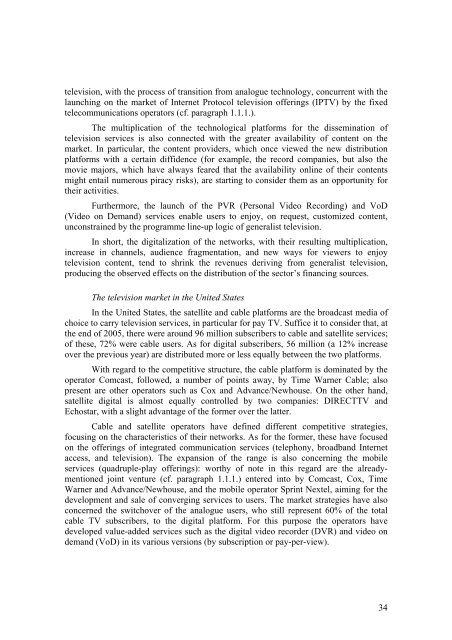Communications Regulatory Authority
Communications Regulatory Authority
Communications Regulatory Authority
Create successful ePaper yourself
Turn your PDF publications into a flip-book with our unique Google optimized e-Paper software.
television, with the process of transition from analogue technology, concurrent with the<br />
launching on the market of Internet Protocol television offerings (IPTV) by the fixed<br />
telecommunications operators (cf. paragraph 1.1.1.).<br />
The multiplication of the technological platforms for the dissemination of<br />
television services is also connected with the greater availability of content on the<br />
market. In particular, the content providers, which once viewed the new distribution<br />
platforms with a certain diffidence (for example, the record companies, but also the<br />
movie majors, which have always feared that the availability online of their contents<br />
might entail numerous piracy risks), are starting to consider them as an opportunity for<br />
their activities.<br />
Furthermore, the launch of the PVR (Personal Video Recording) and VoD<br />
(Video on Demand) services enable users to enjoy, on request, customized content,<br />
unconstrained by the programme line-up logic of generalist television.<br />
In short, the digitalization of the networks, with their resulting multiplication,<br />
increase in channels, audience fragmentation, and new ways for viewers to enjoy<br />
television content, tend to shrink the revenues deriving from generalist television,<br />
producing the observed effects on the distribution of the sector’s financing sources.<br />
The television market in the United States<br />
In the United States, the satellite and cable platforms are the broadcast media of<br />
choice to carry television services, in particular for pay TV. Suffice it to consider that, at<br />
the end of 2005, there were around 96 million subscribers to cable and satellite services;<br />
of these, 72% were cable users. As for digital subscribers, 56 million (a 12% increase<br />
over the previous year) are distributed more or less equally between the two platforms.<br />
With regard to the competitive structure, the cable platform is dominated by the<br />
operator Comcast, followed, a number of points away, by Time Warner Cable; also<br />
present are other operators such as Cox and Advance/Newhouse. On the other hand,<br />
satellite digital is almost equally controlled by two companies: DIRECTTV and<br />
Echostar, with a slight advantage of the former over the latter.<br />
Cable and satellite operators have defined different competitive strategies,<br />
focusing on the characteristics of their networks. As for the former, these have focused<br />
on the offerings of integrated communication services (telephony, broadband Internet<br />
access, and television). The expansion of the range is also concerning the mobile<br />
services (quadruple-play offerings): worthy of note in this regard are the alreadymentioned<br />
joint venture (cf. paragraph 1.1.1.) entered into by Comcast, Cox, Time<br />
Warner and Advance/Newhouse, and the mobile operator Sprint Nextel, aiming for the<br />
development and sale of converging services to users. The market strategies have also<br />
concerned the switchover of the analogue users, who still represent 60% of the total<br />
cable TV subscribers, to the digital platform. For this purpose the operators have<br />
developed value-added services such as the digital video recorder (DVR) and video on<br />
demand (VoD) in its various versions (by subscription or pay-per-view).<br />
34















